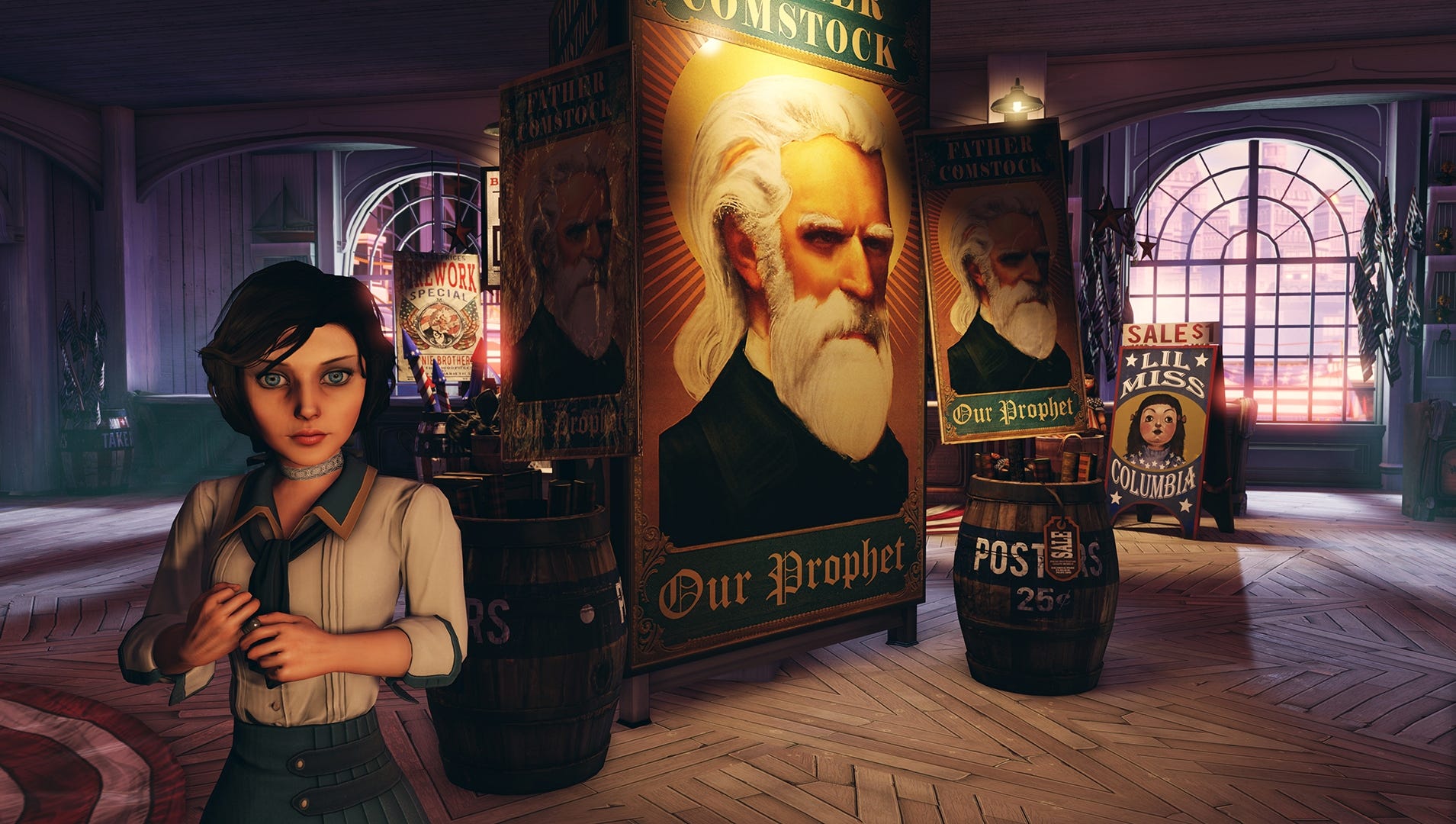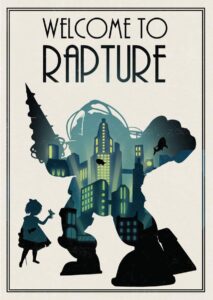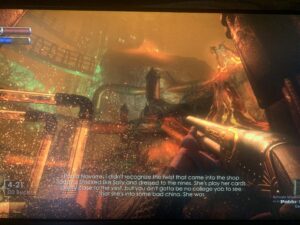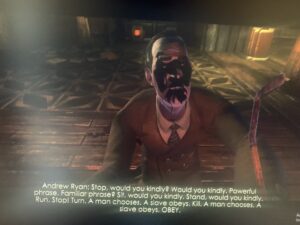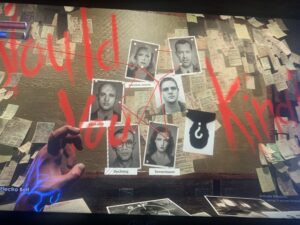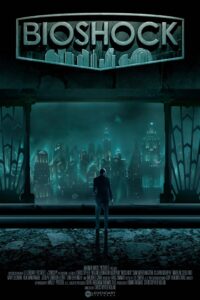Kelly Mulligan
Professor Nyland
ENG 281 OM4
26 October 2021
Bendy and the Ink Machine Analytical Essay
Bendy and the Ink Machine is a horror/action-puzzle game set after the closure of the Joey Drew Studios Inc, a studio that created the adorable fictional black and white films and animations that is Bendy and friends. Henry Stein, the character you play as, was asked to visit the studio by Joey Drew, your longtime business partner, and CEO of Joey Drew Studios Inc, for an unknown reason. After discovering the dark secret that the ink can come to life and create horrid creatures from it, your character must try to escape the studio. For the remainder of the game, you must solve each riddle and puzzle that will aid your escape. You are given some help from Boris, a character from the Bendy and the Ink Machine universe, as well as Allison Angel and Tom, who show up in Chapter 5. You must escape the ink monster-infested studio while trying to avoid death by the antagonists Sammy, Ink Bendy, and the other ink creatures that stalk the halls. Bendy and the Ink Machine enhances player experience through atmospheric tension and jump scares, enhances player investment through encouraging the player to venture into the unknown, and enhances player understanding through background stories offered in interactive items in the game.
Player experience in setting and tension
Bendy and the Ink Machine’s level of interactivity is much like other horror games. Outlast (2013) is a highly reviewed game that, in my opinion, will be considered a classic horror game in the years to come (“Outlast”). Bendy and the Ink Machine mimics some similar mechanics and plot as Outlast– you must escape a location by going through a series of rooms and floors in a building, trying to complete small tasks that will eventually lead to your escape (“Outlast”). While attempting to escape, you must simultaneously avoid the monsters and evil characters in the game who want to kill you.
An animation studio is not normally a person’s first choice when asked to list classic haunted locations- usually, an abandoned insane asylum or a haunted mansion would come to mind first. The creators of Bendy and the Ink Machine successfully made the setting seem scary through the eerie sounds and echoes through the walls and hallways, pitch-black ink dripping from the ceiling and puddling onto the hardwood floors, and unsuspecting jump scares here and there in the abandoned building. The setting has been abandoned for some time, given there are cobwebs all around and desks that seemed as if employees just up and left their drawings and never came back.
The game knows when you pass through a hallway for the first time, and although I know when to expect a jump scare (because I’ve seen gameplays of Bendy and the Ink Machine in the past), the game always caught me off guard by popping a cardboard cutout of Bendy from behind a wall when I would least expect it. Later in the game, you find out that it was Boris who was sticking the Bendy cutouts in your path to mess with you- which is quite clever. Another hostile character messing around with you as you are fearing for your life is unique and hilarious.
Jump scares are a great game mechanic that aid in always keeping the player aware of their surroundings. They add to the tension and fear factor of the game and fit into the mood of the game. Jump scares are always unexpected, and although they’re not always terrifying, they do help tell the story in their own way.
Player investment in the unknown
It is common in video games, especially horror games, for the player and playable character to have zero understanding of why they were in the world they are in. You learn early in the game that you must escape and may spend 70% of the rest of the game trying to escape. In Bioshock™ (2007), you enter a failing underwater oasis called “Rapture,” and your character is told to escape this semi-apocalyptic world and get back to where you are from (“BioShock™ on Steam”). In the world of Bendy and the Ink Machine, you are also in an unknown location and are tasked to find a way out, as well as to figure out why you were in this place, to begin with.
Upon entering the game, the character you play as, Henry, says aloud “Alright, Joey. I’m here. Let’s see if we can find what you wanted me to see” (Chapter 1). It is debatable to determine the exact meaning of what Joey wanted to show Henry, but my belief is Joey knew what had happened to the studio. Joey was aware monsters were being created beneath the floors of where Henry used to work, while the employees of the studio suspected nothing. I believe Joey knew the monsters were going to take over, so after he closed the studio in 1959, the ink monsters were able to spread and take control over the building.
The mystery of the unknown drives people forward. Murder mystery novels and films are never not interesting. Bendy and the Ink Machine gives the opportunity to solve the riddles and puzzles that help you escape, as well as the wonderment of how and why these ink monsters came to life and why you are even in that predicament in the first place.
Player understanding of the world
Thankfully, despite all this mystery, there are some aspects of the game that help answer some questions you might not have thought of. The audio logs are a helpful feature that enhances the player’s understanding of the Bendy and the Ink Machin world and backstory. Much like in Bendy and the Ink Machine, Bioshock™ features audio logs throughout the levels of the game (“BioShock™ on Steam”). Audio logs use recordings of other characters in the game’s world but are not always featured as interactable characters. These audio logs can be avoided and not necessary to the gameplay, except when the game lets you know if you must listen to a specific audio log to keep the gameplay moving along. However, audio logs can provide some more insight into the background story of the game for the player before the time when the game began.
In Bendy and the Ink Machine, the player is not required to click on every audio log, but it is extremely helpful to do so. One audio log, in particular, gives the player hints as to where to find the missing key to unlock a broom closet in Chapter (2), which provides you with the next audio log that helps you unlock the door to the recording studio. This is the only occurrence that I can recall where the audio log leads the player to another audio log to progress the gameplay forward.
Bendy and the Ink Machine provides players with a classic horror puzzle game structure, added with complex lore and creative action. This game does a fantastic job of creating a unique horror atmosphere and story with an innocent setting idea. Their ability to create a horrific atmosphere through music and sound, as well as setting interactivity with the player to improve their understanding of the world, is incredibly genius. This game is highly underrated, and although it has its flaws (such as puzzles that take way too long to complete), the quick story run time and the intense horror levels in some plot points deserve more recognition.
Works Cited
“BioShock™ on Steam.” Steam, 21 Aug. 2007, store.steampowered.com/app/7670/BioShock/.
“Outlast.” Red Barrels, 4 Sept. 2013, redbarrelsgames.com/games/outlast/.
Tucker, Evan. “What’s the Deal with: Bendy and the Ink Machine (Spooky October Spectacular).” Canyon Echoes, 29 Oct. 2018, canyonechoes.org/15968/entertainment/whats-the-deal-with-bendy-and-the-ink-machine-spooky-october-spectacular/.




